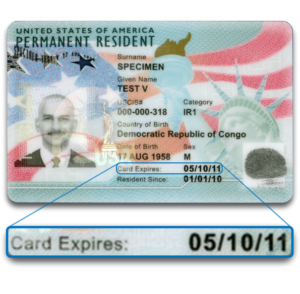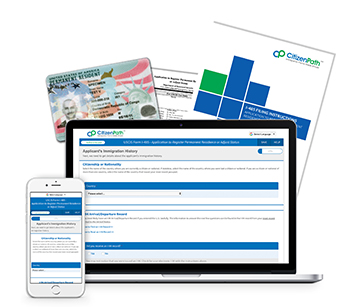Form I-751, Petition to Remove Conditions on Residence
Form I-751 Overview For:
Form I-751 Explained
What is Form I-751, Petition to Remove Conditions on Residence?
Conditional residents who obtained status through marriage file Form I-751, Petition to Remove Conditions on Residence, to request that the conditions on residence be removed and subsequently become lawful permanent residents. It's critical that conditional residents file the form on-time and with ample evidence to prove they entered the marriage in good faith. The petition removes conditions on residence and finalizes the permanent resident process. Failing to file the petition can create a deportation problem. An approval on the I-751 petition results in a 10-year green card and the ability to live and work permanently in the United States.
The focus of this article is the USCIS form itself. However, a significant part of filing an I-751 petition package is the supporting documentation. In particular, the burden is on petitioners to prove that the marriage was entered in good faith. For more extensive information on this topic, refer to our content that addresses how to prove a bona fide marriage.
USCIS I-751 Online Filing
Can Form I-751 be filed online?
At this time, there is no way to submit Form I-751 electronically, but you can prepare the form with an online service to make sure you do it correctly.
USCIS has not introduced online filing for this form. Regardless, e-file doesn't necessarily mean you get quick processing. If you are interested a quick approval, focus on submitting a well-prepared petition package. It’s the difference between saving a couple of days with online filing versus saving several weeks with smooth processing. What’s more, USCIS is not your advocate. They are not looking out for your best interests. If you include information that damages your immigration future, USCIS isn’t going to correct you.
For people who want to make sure they are preparing the petition correctly, CitizenPath offers an affordable service created by immigration attorneys. CitizenPath’s Removal of Conditions Petition Package will make the petition easy and give you alerts if there’s a problem. You’ll also receive detailed filing instructions so you know exactly which supporting documents to submit with your petition. CitizenPath even provides a money-back guarantee that USCIS will approve your petition.
The Right Time to File a Petition
When should I remove conditions on my green card?
Joint Petition
Generally, couples should file Form I-751, Petition to Remove Conditions on Residence, in the 90-day period before a conditional green card expires. Form I-751 is a joint petition. That means that you and your spouse will file the petition together. USCIS will likely reject petitions mailed more than 90 days before the expiration of the conditional period. If the couple does not file the I-751 petition before the expiration, the conditional resident becomes removable (deportable). Therefore, filing the petition within the 90-day period before status expires is extremely important.
It’s easy to determine when to file Form I-751. Look at the front of your green card. You should see a “Card Expires” date. File to remove the conditions on residence any time during the 90 days that precede the Card Expires date. For example, if your card expires on 12/31/2023, you can file the I-751 petition as early as 10/2/2023. You must file it by 12/31/2023. It is possible to file late, but it gets more complicated.

Filing without the Spouse
However, there are exceptions for conditional residents that to request to waive the joint filing requirement. Requesting to waive the joint filing requirement may be necessary for widowers or individuals seeking divorce. Petitioners may potentially select one or more of the following reasons:
- Death of the spouse;
- The marriage was entered in good faith but was terminated through divorce or annulment;
- The U.S. citizen or permanent resident spouse was abusive; or
- Termination of status and removal from the United States would result in an extreme hardship.
For petitioners filing with a request to waive the joint filing requirement, there is more flexibility in the timing. The conditional resident may file early. Anyone seeking a waiver to the joint filing requirement should speak to an immigration attorney first.
Form I-751 Instructions
How do I fill out I-751?
CitizenPath's easy-to-use website helps you prepare the petition quickly and accurately. Our online service provides step-by-step Form I-751 instructions so that you can fill out the petition in just a few minutes. We even give you a money-back guarantee that USCIS will approve your petition.
If you prefer to fill out the PDF-based application, you can download instructions from USCIS or follow this summary of directions.
General Guidance
- Type or print answers in black ink only.
- Enter “N/A” if an answer is not applicable and "NONE" if your answer is zero.
- Foreign language documents must be accompanied by a full English certified translation.
- Submit your petition with the current USCIS filing fee. Use a personal check, money order, cashier’s check or use Form G-1450 to pay by credit card.
- Submit photocopies for all supporting documents unless an original document is specifically required.
Part 1
- For Names, use your current legal name. If you’ve legally changed your name since the conditional green card was issued, submit a copy of the legal name change document (such as a marriage certificate). Be sure to list any other versions of your name used in the past such as a maiden name.
- For Mailing Address, provide any address where you can safely receive mail. Include your physical address only if it is different than your mailing address.
- For Additional Information, a "Yes" answer to items 18-20 is generally problematic. Seek the advice of an immigration attorney if you must answer "Yes." If you've ever lived at a different address since becoming a permanent resident, you'll need to include a separate page that details these addresses along with the dates at each.
Part 2
- For Biographic Information, answer how you identify in terms of race and ethnicity. Indicate other details about your height, weight, eye color and hair color.
Part 3
- For Joint Filing, answer if you continue to be married, living in marital union, and will be filing this petition with your spouse (or parent's spouse for children). Most people use this option.
- For Waiver or Individual Filing Request, answer if you are not filing jointly and must request a waiver for the joint filing requirement.
Part 4
- For Information About the U.S. Citizen or Lawful Permanent Resident Spouse, provide details about the conditional resident's spouse. In the case of a child filing Form I-751 separate from a parent, use the parent's U.S citizen or permanent resident spouse's information.
Part 5
- For Information About Your Children, provide all details about your children. Generally, USCIS considers children to be any biological, step, or adopted dependents under the age of 21. If your dependent child acquired conditional residence on the same day as you or within 90 days thereafter, you may include them on this same petition.
Parts 6, 7, 8, 9 and 10
- For Accommodations, indicate any disability or impairments for which you would like USCIS to provide accommodations. USCIS will make accommodations for you at the time of your biometrics screening and any other appointments.
- For Petitioner's Statement, the conditional resident should provide the requested information.
- For Spouse's or Individual's Statement, the conditional resident's spouse should provide the requested information if filing a joint petition.
- For Interpreter and Preparer, provide information if applicable. If you and your spouse prepared your Form I-751, it’s only necessary to sign as the “petitioner" and "spouse.” If another person translated or prepared the petition for you, be sure Parts 9 and 10 are filled in and signed appropriately.
This is an abbreviated list of Form I-751 instructions. We highly recommend that you download USCIS instructions or use CitizenPath’s service to prepare the petition. CitizenPath provides filing instructions customized to your situation. You’ll get detailed I-751 instructions that explain which supporting documents to submit, how to organize, and where to mail.
Submit the Petition
Where should I mail Form I-751?
USCIS accepts the I-751 petition via mail only. They do not want petitioners to submit Form I-751 in-person at USCIS offices.
At the time of writing this guide, USCIS receives petitions at two locations called lockboxes: Elgin, IL and Phoenix, AZ. Although USCIS receives your petition package at these locations, they will process them somewhere else. If you have an interview, it will be at a USCIS office near that address you provide.
Petitioners who live in the following states will file at the Elgin lockbox: Connecticut, Florida, Georgia, Guam, Illinois, Indiana, Maine, Maryland, Massachusetts, Michigan, New Hampshire, New Jersey, New York, Ohio, Pennsylvania, Rhode Island, South Carolina, Vermont, or Wisconsin.
If you are sending via the U.S. Postal Service, mail the package to:
USCIS
Attn: I-751
P.O. Box 4072
Carol Stream, IL 60197-4072
If you will send via a courier service like FedEx, UPS or DHL, mail the package to:
USCIS
Attn: I-751 (Box 4072)
2500 Westfield Drive
Elgin, IL 60124-7836
Petitioners who live in other states and territories will file at the Phoenix lockbox.
If you are sending via the U.S. Postal Service, mail the package to:
USCIS
Attn: I-751
P.O. Box 21200
Phoenix, AZ 85036-1200
If you will send via a courier service like FedEx, UPS or DHL, mail the package to:
USCIS
Attn: I-751 (Box 21200)
1820 E. Skyharbor Circle S, Suite 100
Phoenix, AZ 85034-4850
Please note that USCIS does occasionally change lockbox locations that receive petitions. Refer to your CitizenPath filing instructions or the USCIS website for the most up-to-date information.
I-751 Petition Processing Time
How long does it take?
USCIS is reporting processing times in excess of one year. CitizenPath customers generally experience some of the best processing times. Well-prepared petitions have the best chance to skip the interview and get a quick approval. For an in-depth look at what happens after filing Form I-751, visit our I-751 processing time line.
Reporting for processing times only includes forms that were successfully filed. If an individual does not correctly prepare a form or otherwise does not satisfy eligibility requirements, USCIS will reject or deny these requests. For the most recent year, USCIS reported the following national statistics:
USCIS Rejections in 2024
MODERATE RISK
USCIS Denials in 2024
LOW RISK
How CitizenPath Helps You
Is there an inexpensive way to file the I-751 petition?
CitizenPath's affordable, online service makes it easy to prepare Form I-751, Petition to Remove Conditions on Residence. Designed by immigration lawyers, the Removal of Conditions Petition Package helps you eliminate the common errors that create delays, rejections and even denials. That's because the service alerts you when your answer to a question may be a problem. You'll also get customized filing instructions based on your situation. It's a powerful, do-it-yourself tool that puts you in control. And we've got your back -- CitizenPath provides live customer support and provides a money-back guarantee that USCIS will approve your petition.
STEP 1 | Check Eligibility | |
We're going to ask you a few questions to make sure you're eligible and preparing the correct form. | ||
STEP 2 | Prepare Form I-751 | |
Our software will guide you through the I-751 petition using simple step-by-step instructions. | ||
STEP 3 | Download, Print and File | |
Once you're completely satisfied, you’ll be able to print your I-751 and customized filing instructions. | ||



